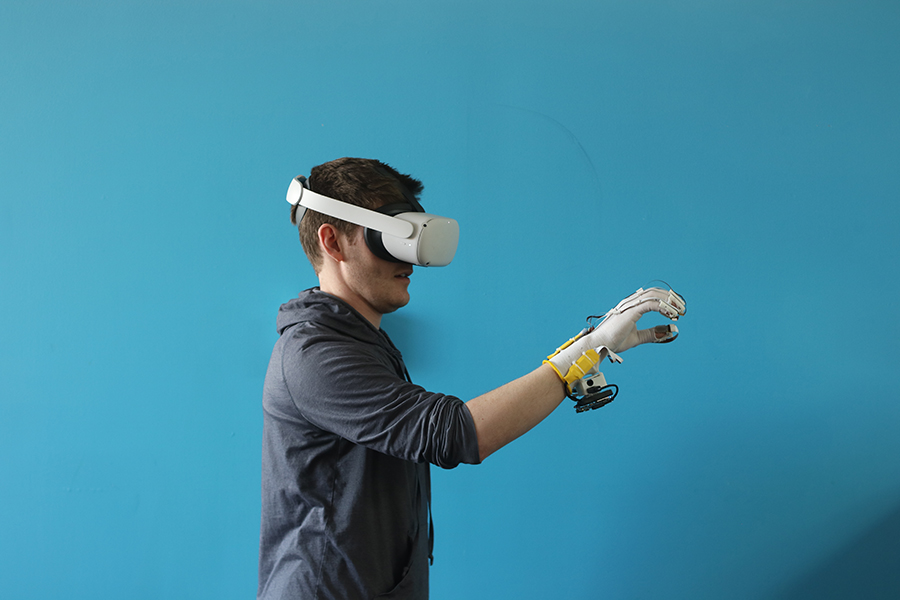Fluid Reality Haptic Gloves Bring Ultra-Sensitive Touch to VR
Marylee WilliamsThursday, April 4, 2024Print this page.

Researchers in Carnegie Mellon University's School of Computer Science have developed a lightweight, low-cost haptic glove that delivers detailed touch in virtual reality. The device could make haptics more commercially available as the use of audiovisual immersion technologies, spatial computing, the metaverse and other extended reality applications continues to grow.
The Future Interfaces Group (FIG) in the Human-Computer Interaction Institute developed Fluid Reality, a high-resolution, untethered haptic glove that lets users experience a detailed sense of touch in virtual spaces. The whole system, including battery and Wi-Fi equipment, fits on the hand and wrist. The gloves can simulate a range of sensations, from light touches like the texture of corduroy to the feeling of individual violin strings or the sharp corner of a box.
The gloves are built around small, embedded electroosmotic pumps in the glove's fingertip arrays. These pumps can inflate or deflate 32 independent pressure actuators or pixels on every finger pad, creating fine-grain tactile sensations. When wearing the glove, the user's hand is tracked in virtual reality.
"In software, we're calculating the 3D geometry of an object that you're reaching for, and when we detect an overlap in contact with that, we can inflate or turn on these pixels," said Craig Shultz, who worked on Fluid Reality as a postdoctoral researcher in the FIG lab and is an incoming assistant professor of electrical and computer engineering at the University of Illinois, Urbana-Champaign.
Each finger pad haptic array is about the size of a penny. In total, the system weighs about half a pound. Researchers estimate that if produced commercially, the gloves would cost a few hundred dollars. Current commercially available haptic gloves that can incorporate touch in these virtual spaces either use simple vibrations or are costly and bulky. One glove that offers users a similarly detailed sense of touch costs around $5,500, is tethered to a backpack and requires a monthly subscription.
Vivian Shen, a Ph.D. student in the FIG lab, explained that lighter touches, like textures, posed a challenge when working on Fluid Reality. During the research, the team simulated surfaces like metal grates, corduroy or pimply skin. Shen said they created 2D grayscale images that correlated with the haptic sensation, allowing researchers to put textures on any surface in virtual reality.
"Plenty of haptic gloves have your entire fingertip feel pressure, but few have individual tiny haptic pixels on them," Shen said. "By achieving this sort of high-resolution, fine-grained haptic feedback, we're able to get the whole scale— from the lightest touch of a tiny corner to simulating compliance, like pressing into hard and soft objects."
Training simulations are one area where these lower-cost, high-resolution haptic gloves are useful. Imagine enabling a dental student to practice without a patient in the room or a pilot to land a plane without being in the sky.
"A lot of simulation environments lack that haptic element, and you're not going to be able to train someone in certain fine-grained or medical tasks without having access to haptics," Shen said.
The FIG lab team spent months iterating on the design of the hardware and software for Fluid Reality.
"I think it shows the power of Carnegie Mellon and the FIG lab that we were able to bring fabricators, hardware people, software people and HCII people all in one project to get it done," Shultz said. "And it was an excellent example of the power of interdisciplinary work, wrapped up in one project."
Fluid Reality has been spun out into a startup that Shultz says is focused on the core technology — the fingertip actuators. Shen will continue her research with the FIG lab into the widespread accessibility of haptics adding this element to devices easily and affordably.
Learn more about Fluid Reality on the company's website.
Aaron Aupperlee | 412-268-9068 | aaupperlee@cmu.edu
